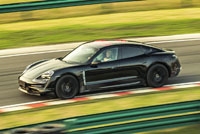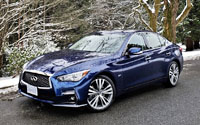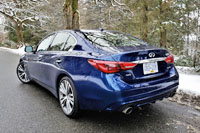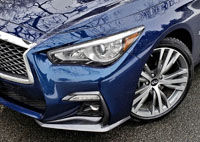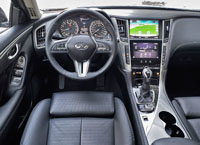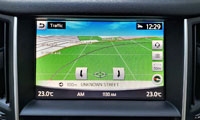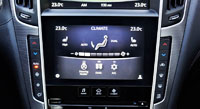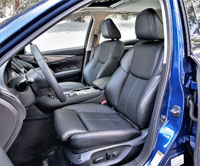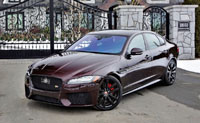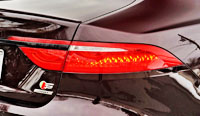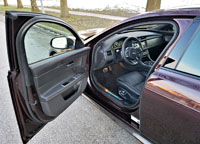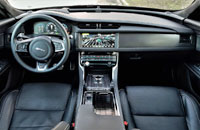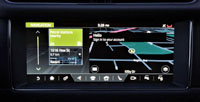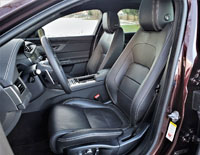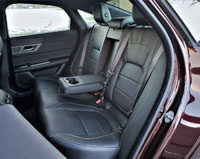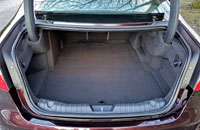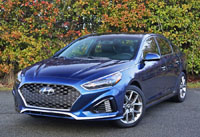
Hyundai’s Sonata has been around for decades. Just over three actually. During its 31-year tenure the South Korean brand has given it a fairly even mix of dramatic designs and comparatively less expressive styling, the latter seeming to win more buyers.
A quick glance back into the rearview mirror shows the 1998 through 2004 fourth-generation and 2009 through 2014 sixth-generation models offering particularly daring designs, with a comparatively conservative 2004 through 2009 fifth-generation filling the gap. I might end up throwing my “dramatic” styling equals success theory out completely as that relatively modestly sedan sold very well, and while I spent at least one week with all of the above generations and every one since, all of which impressed, I actually had a V6-powered top-tier version of the latter car in my position as a long-term test car for more than a year, and experienced no problems while totally enjoying its comfort and performance (as my weekly reports confirmed).
Today’s 2014 through 2019 gen-seven model is the best Sonata yet, but before its extensive 2018 mid-cycle update it was amongst the least visually inspiring generations. Don’t mistake my lack of excitement for criticism, as the 2014 through 2017 Sonata was still attractive enough for plenty of mid-size four-door family sedan buyers, but we’d best not call this level of reconstructive surgery a facelift.
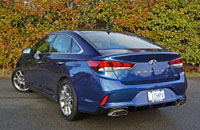
Both 2018 and 2019 Sonata models, which are identical, include a totally reworked grille that completely said goodbye to the front fascia’s sharply angled hexagonal design, a somewhat yawn-inducing generic look if I can be so bold, substituted by a more organically shaped opening that’s helped to visually separate Hyundai and its new Genesis luxury brand. Genesis, which merely rebadged Hyundai’s Genesis Sedan as the G80 as part of its transformation, appears to be keeping more of the outgoing Hyundai grille design while adding a “V” shape to the centre bottom, much like the side view of a brilliant cut diamond as revealed on its new full-size 2020 G90 luxury sedan.
Back to the current Sonata, its curvaceous new grille is bookended by a nice complex set of headlamp clusters filled with ovoid projector beams (LEDs in my tester) surrounded by attractive LED daytime running lights, these hovering above a neatly stacked set of six LED fog lamps on the lower front corners.
My tester’s sportier Ultimate trim gets stylish darkened chrome around the otherwise black gloss grille, lower fascia, and headlight surrounds that smartly continue rearward along the front fenders and the entire shoulder line along the side windows before wrapping up and around the greenhouse before meeting back up at the base of each A-pillar. This unique signature design element began with the aforementioned sixth-gen Sonata way back in 2009, and will once again make its dramatic statement for the upcoming 2020 model, a car that take all of the styling cues shown here and expands on them in drama and actual size, while completely redoing rear styling. There’s plenty more dark chrome and loads of glossy black trim on this Ultimate example too, the diffuser style rear apron nicely matching the front fog light bezels, all of which mirror the all black glass and high-gloss roof, this partially because of its panoramic sunroof. I have to admit, the 2018 update made a rather ho-hum Sonata into a great looking mid-size sedan.

Of course, it needs to be in order to survive. Not only is it up against some very stiff competition thanks to Toyota’s latest Camry being downright seductive in its sportiest XSE trim line, the latest Honda Accord providing a lot more premium-like presence than ever before, an all-new Nissan Altima improving styling while offering standard all-wheel drive, plus plenty of other brands tempting consumers with high performance or fuel-efficient hybrid and plug-in alternatives, not to mention Kia and Volkswagen complementing their respective Optima and Passat family sedans with sporty four-door coupe variants dubbed Stinger and Arteon, but the entire car sector under serious threat from crossover SUVs.
Out of the 14 mid-size sedans currently vying for your attention, only four saw an increase in year-over-year Canadian sales through the first three quarters of 2019, and the Sonata isn’t one of them. The segment-leading Camry’s 11,579 deliveries are up 4.18 percent since the close of Q3 2018, growth that pales in comparison to the third-place Ford Fusion’s 33.43-percent gain, although its total sales are only 7,280. The two others in positive territory are marginal players to say it kindly, with Honda’s Clarity plug-in hybrid up 12.37 percent to 890 units, and Buick’s Regal having increased its take-rate by a whopping 48.71 percent, albeit only to 635 deliveries.

The biggest loser is Volkswagen’s Passat down 78.24 percent to just 570 units, but Kia’s Optima didn’t fare much better with sales of 1,363 units resulting in a 52.09-percent downturn. A quick glance at some others like the Altima that lost 43.34 percent for 2,568 units despite its recent redesign, and Mazda6’s that took a 42.76-percent nosedive to 1,130 units, doesn’t make the Sonata’s mere 14.18-percent reversal look that bad, while the 3,346 units Hyundai delivered puts it in a strong fifth place, behind the Camry, Accord, Fusion and Malibu, yet ahead of the Altima, Optima, Subaru Legacy, Stinger, Mazda6, Clarity, Regal, Passat, and Arteon. Announcement of the Fusion’s upcoming demise might make it easier for those remaining, although it’s also a sobering sign of this once mighty category not being as essential to carmakers as it once was.
All this said, the review you’re reading is more of a respectful adieu to the outgoing 2019 Sonata ahead of ushering in the all-new 2020, and therefore some of us can appreciate a car that helped define Hyundai’s new styling direction over its two-year tenure, while others are deciding if it will soon grace their driveway. I have a lot of good to say about this particular Sonata Ultimate tester, continuing on from my styling overview to its very impressive interior filled with upscale finishings and more features than you’re likely to find in any one of the competitors mentioned above.
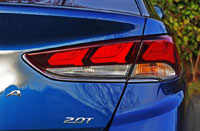
A tasteful array of high-quality, soft-touch composites in all the usual places join textured and brushed metal-like trim and inky piano black detailing throughout, while the medium-grey cabin sports a classy set of identically coloured seats in perforated leather upholstery with light-grey piping around their edges, which matches light-grey stitching on the bolsters, with the latter complementing light-grey stitching found elsewhere around the interior, particularly on the door panel inserts, on the shifter boot, and in baseball-stitched style around the inside of the leather-wrapped flat-bottom sport steering wheel rim.
That steering wheel not only looks the part of a performance car, but its thick padded rim, nicely indented thumb spats, and overall meaty feel comes across a lot more Veloster N than Azera (RIP, in Canada at least), while the placement of the paddle shifters is so ideal they really enhance the overall driving experience. All is combined with ample steering column rake and reach, plus an eight-way powered driver’s seat with two-way lumbar, both allowing my long-legged, short-torso five-foot-eight frame to get completely comfortable while providing ideal control of directional duties, unlike some in the class that don’t fit me as well.
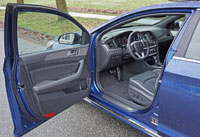
During the same week I also had Toyota’s new Camry XSE, which by all styling inferences appears to be the sportiest new mid-size sedan on the market. It’s a significant improvement over the previous model in every way including steering column reach, but it still doesn’t fit me as well. What’s more, the steering wheel doesn’t come close to feeling as sporty or allowing as much control as this Sonata’s, even from a styling standpoint. Don’t get me wrong as Toyota has done a commendable job with the new Camry interior, making its finishing more refined and its overall look a bit more upscale than this Sonata, but as far as real hands-on performance goes, it doesn’t come anywhere near close. What’s more, the Sonata’s steering wheel is heatable from its mid-range up, while Toyota doesn’t even offer a heated steering wheel in the Camry.
The most notable Camry XSE and Sonata Ultimate differentiators are the seats, with the latter model featuring two of the best front sport seats in the family sedan class. Not only are the embossed with cool “Turbo” insignias up top, and detailed out with all the niceties mentioned earlier, but their deep side bolsters do an excellent job of holding butt and torso in place during hard cornering. You’ll need to hang onto something other than the steering wheel if you want to stay put in the Camry’s driver’s seat while attempting the same lateral Gs, because Toyota’s seats leave you sitting on top of their cushions rather than ensconced within. I didn’t find the Camry’s seats comfortable either, not even in the more luxurious XLE version, but the seats in the Sonata Ultimate are wonderful, and fully supportive in every way you’d want from a sport sedan. The Sonata’s three-way front seat heaters also get toastier than the Camry’s in their top temperature setting, plus the Hyundai includes three-way front seat ventilation that won’t be available to top-line Camry buyers until the 2020 model arrives.

Even the Sonata’s rear seats offer two-way derriere warmers next to the windows in mid-range Preferred trim and above, not to mention nicely carved out support that makes them feel great on the backside, albeit not so much to render the centre position useless. Side window sunshades, found in Luxury and Ultimate trims, can’t be had with a Camry either, while rear seat passengers benefit from plenty of other features like LED reading lights overhead, individual air vents, a nice wide folding centre armrest with integrated cupholders, deep door pockets with bottle holders, and more. A panoramic sunroof on Luxury and Ultimate trims makes the rear passenger compartment feel more open and airy than it would otherwise be, although even less opulent models are hardly short on side window visibility.
It’s roomy in back too, with plenty of knee space, enough legroom to almost completely stretch out my legs while wearing winter boots, four to five inches to the door panels, plus I still had about three and a half inches above my head, so taller folks should fit in without problem.
The trunk is large at 462 litres (16.3 cubic feet), while the lid can be opened with a button on the dash or automatically by standing behind the car with the ignition off and proximity-sensing key in pocket. It’s nicely finished with carpeting all the way up the sidewalls, including the trunk lid, while each side of the carpeted seatbacks fold forward in the usual 60/40-configuration via pull-tabs just underneath the rear shelf.

Everything mentioned so far comes standard in top-line Ultimate trim, including a sharp looking set of 18-inch double-five-spoke alloy wheels wrapped in 235/45R18 Michelin all-season tires (replacing 16- or 17-inch Kumhos) directed via special rack-mounted motor-driven power steering (R-MDPS) with a dual-pinion steering rack, an exclusive twin-scroll turbocharged and direct-injected 2.0-litre four-cylinder engine with dual continuously variable valve timing and two-stage variable induction making 245 horsepower and 260 lb-ft of torque (replacing the base 2.4-litre four with 185 hp and 178 lb-ft of torque), an eight-speed automatic with manual mode and paddle shifters (instead of a six-speed automatic), as well as the special leather sport seats noted earlier, plus the aforementioned 3D Three-dimensional Overlay Method (T.O.M) metallic inlays.
I’m itemizing the majority of each trim’s standard features because value for money has always been one a great way to judge any Hyundai against its peers, and considering this 2019 Sonata Ultimate goes for just $37,199 plus freight and fees, it’s hard to argue against it. After all, a similarly powered Camry with fewer features tops $41k, about 10 percent more than this full-load Sonata, while it’s also a couple of thousand pricier at its lowest end too. That base Essential trim can be had for just $24,899, while at the time of writing Hyundai was offering up to $2,000 in additional incentives. You can find out more right here at CarCostCanada, right on the same page that gives you detailed 2019 Sonata pricing, including trims, packages and individual options, plus rebate info and dealer invoice pricing that could save you thousands.
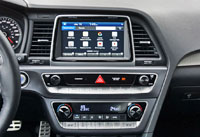
Yet more features pulled up to this Ultimate model from the $34,899 Luxury trim include the aforementioned LED headlamps with adaptive cornering and auto high beams, the cooled front seats, the rear window sunshades and powered panoramic sunroof, plus aluminum treadplates, chromed inner door handles, an electric parking brake, an auto-dimming centre mirror, a HomeLink universal garage door remote, a six-way powered front passenger seat, driver’s seat and side mirror memory, an 8.0-inch high-resolution infotainment touchscreen with navigation, an excellent sounding 400-watt nine-speaker Infinity audio system, wireless device charging, rear seat heating/ventilation/AC ducts, rear parking sensors, driver attention warning, adaptive cruise control with stop-and-go, forward collision warning with pedestrian detection, and lane departure warning with lane keep assist.
Features pulled up to the Unlimited from mid-range $28,799 Preferred trim include the stitched leatherette door inserts, heated steering wheel rim, rear seat heaters, and proximity trunk release mentioned before, as well as two-zone auto climate control, satellite radio with a rooftop shark antenna, remote engine start, and BlueLink connectivity, while the $27,699 Essential Sport model provides its sport grille, dark chrome and sportier exterior detailing, sport-tuned suspension, LED tail lamps, front door handle welcome lighting, proximity-sensing keyless entry, sport-style Supervision instrument cluster with a 4.2-inch TFT LCD multi-function display, shift paddles, eight-way power driver’s seat, and aluminum pedals.
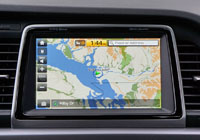
Lastly, standard features included with this Ultimate model from base Essential trim are as follows: automatic on/off headlamps, LED daytime running lights, powered and heated exterior mirrors with integrated LED turn signals, a leather-wrapped multifunction steering wheel, speed-sensitive variable intermittent windshield wipers, heatable front seats, Android Auto and Apple CarPlay phone integration, Bluetooth with streaming audio, micro-filtered air conditioning, blindspot monitoring with rear cross-traffic alert, the usual active and passive safety gear, plus plenty more.
To be fair to the Camry, which has taken quite a beating while being compared directly to the Sonata Unlimited throughout this review, the mid-size Toyota provides a more sophisticated primary gauge package thanks to a more advanced multi-information display (MID) boasting a bigger, more modern looking TFT screen that neatly curves around the outside of each analogue dial, plus it also comes with more functions. Just the same, the Sonata’s MID is bright, clear and hardly short on features.

The car’s centre stack is more vertical than the Camry’s, which is a more modern horizontal layout, not that it matters from a functional standpoint, but it theoretically allows for a larger display (the top-line Camry’s 8.0-inch touchscreen isn’t any larger though) and more room for switchgear around it (the 2020 Sonata makes up for this in a big 12.3-inch way), and therefore the Sonata’s dash design appears more conventional than the Camry’s as well, but once again this has more to do with the 2019 Sonata’s end of lifecycle issues than not technically measuring up (upcoming reviews of the new 2020 Nexo and 2020 Palisade SUVs will expose Hyundai’s infotainment leadership in more detail). I like how the current Sonata’s touchscreen sits high on the centre stack, making it easy to read while driving, and its clear, high-resolution display provides good depth of colour and nice graphics. Its operating system is quick as well, while all functions are generally easy to sort out.
I found the quality of Sonata switchgear good too, particularly the steering wheel controls and array of buttons, knobs and switches on the centre stack, some of this latter group detailed out with an attractive aluminum-like finish. The upper row of these aluminized toggles is set aside for audio and infotainment system functions, while the bottom row is for the automatic heating and ventilation system, plus the heated and cooled seats as well as the heated steering wheel rim. Under this is a rubberized tray for your smartphone that doubles as a wireless charging pad, while yet more connectivity sits just above on a panel integrating two 12-volt chargers, a USB port, and an aux plug (we can expect more USB ports and fewer old tech as part of the 2020 redesign).
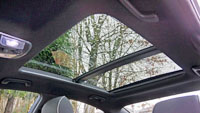
With the thick, flat-bottom, paddle shifter-enhanced steering wheel rim in hands, and the nicely bolstered driver’s seat underseat, the Sonata Ultimate felt considerably more fun to drive than the Camry XSE, even without the latter car’s more powerful V6. The top-tier Camry is quite a bit quicker in a straight line, shaving about a second and a half off the Sonata Ultimate’s mid-seven-second 0-100 km/h sprint, as long as you manage to stop the front wheels from spinning too much, but straight-line acceleration only one performance criterion, and certainly not most important to me.
Sure, making surrounding traffic almost instantly disappear in the rearview mirror can be fun while behind the wheel of a Porsche 911 Turbo or something equally fast, but trying to do so in a Sonata or Camry simply makes you look juvenile. I found the Sonata Ultimate’s 2.0-litre turbo moved me out of the starting blocks fast enough, while its eight-speed automatic swapped gears quicker than the Camry’s eight-speed gearbox, particularly when its Drive Mode Select system was switched from Comfort, past Eco, into Sport mode, each of these making adjustments to steering, engine, and transmission responses. For my tastes, the high-revving top-level Sonata engine was a great deal more enjoyable than the Camry’s V6 when pushed hard at speed, while having less weight over the front wheels made for nimbler high-speed handling with less understeer.
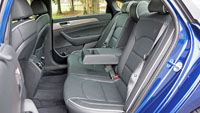
Yes, the Sonata Ultimate manages fast-paced corners better than the Camry XSE, the Hyundai reacting quicker and feeling more stable. The Toyota had a tendency to push its front tires out of its lane when driven similarly over the same circuitous roadway, while becoming its rear tires didn’t feel as hooked up either, and this is in spite of coming equipped with bigger 19-inch alloys on 235/40 all seasons. Throw the Sonata Unlimited’s driver seat superiority into the mix and it’s no contest.
As for fuel economy, you’d think Hyundai’s 2.0-litre turbo-four would annihilate Toyota’s old 3.5-litre V6, but the Sonata Ultimate’s claimed rating of 10.4 L/100 km city, 7.4 on highway and 9.1 combined is only a fraction better than the Camry XSE’s 10.7 city, 7.4 highway and 9.2 combined rating. Another nod to Toyota is the inclusion of the eight-speed automatic throughout the Camry range, which helps its less formidable four-cylinder trims walk away with an ultra-thrifty 8.1 city, 5.7 highway and 6.9 combined rating, which is far better than the 2.4-litre equipped Sonata’s stingiest rating of 9.2, 6.8 and 8.1.
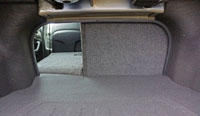
Now that I’m griping, the Sonata’s proximity-sensing automatic trunk opener doesn’t seem to work when the car is already unlocked, and with no button in back to open it manually you’ll want to remember to do so from the driver’s position before getting out. The Camry’s approach, which includes a button on the trunk lid that unlocks by proximity sensing, is easier to live with. I also like the Camry’s heated front seats, which turn on (or stay off) automatically upon restarting the car, and stay set at the previous temperature. The Sonata’s heatable front seats require your attention each time you climb inside.
Of course, a lot of other qualities keep the Camry on top of the mid-size sedan class hierarchy, and I promise to cover these in a future road test review, while there’s no shortage of credible competitors in this segment either, as mentioned at length before, yet if buying into this category you’d be wise to spend some time with the Sonata before choosing something else.
Story credit: Trevor Hofmann
Photo credit: Karen Tuggay


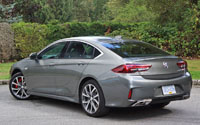
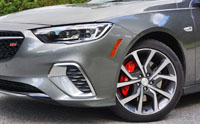

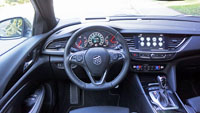

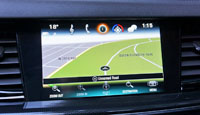
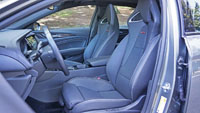
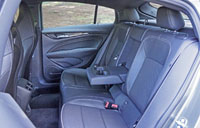

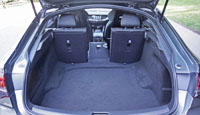

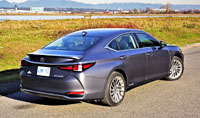
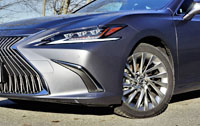
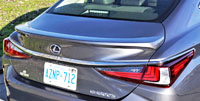
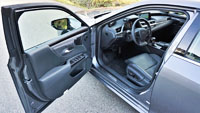
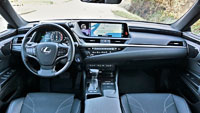

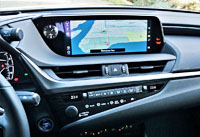

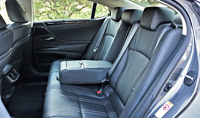
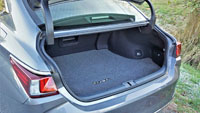
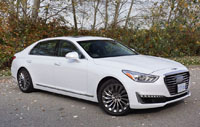
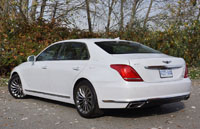
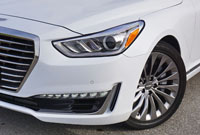

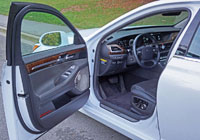


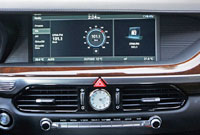
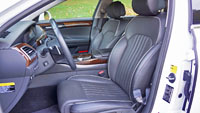


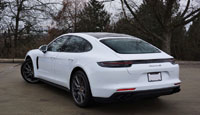




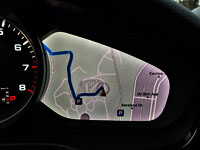
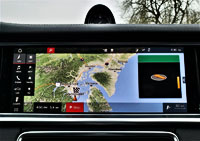
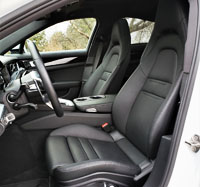

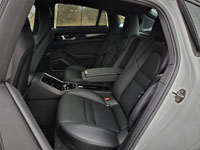
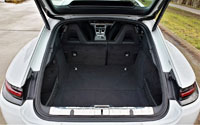


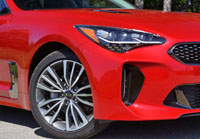

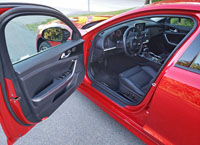

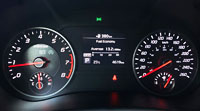

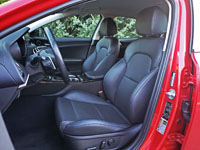
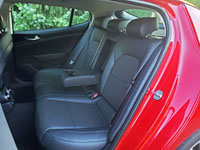

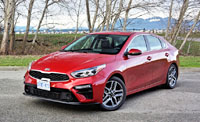
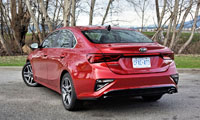
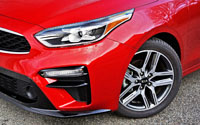
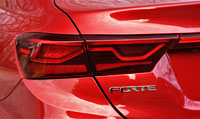
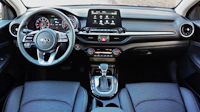


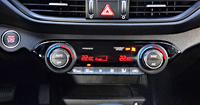
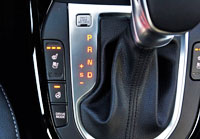
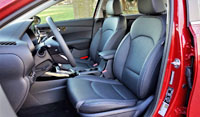
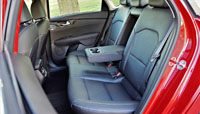 After setting up the driver’s seat for my body type, I sat directly behind in order to test rear seat roominess. The result was loads of space for my feet, plus about five inches in front of my knees, another three and a half or so over my head, about five beside my outer shoulder, and four next to my hip. In other words, the Forte provides a lot of room for rear passengers, and plenty of comfort too.
After setting up the driver’s seat for my body type, I sat directly behind in order to test rear seat roominess. The result was loads of space for my feet, plus about five inches in front of my knees, another three and a half or so over my head, about five beside my outer shoulder, and four next to my hip. In other words, the Forte provides a lot of room for rear passengers, and plenty of comfort too.
